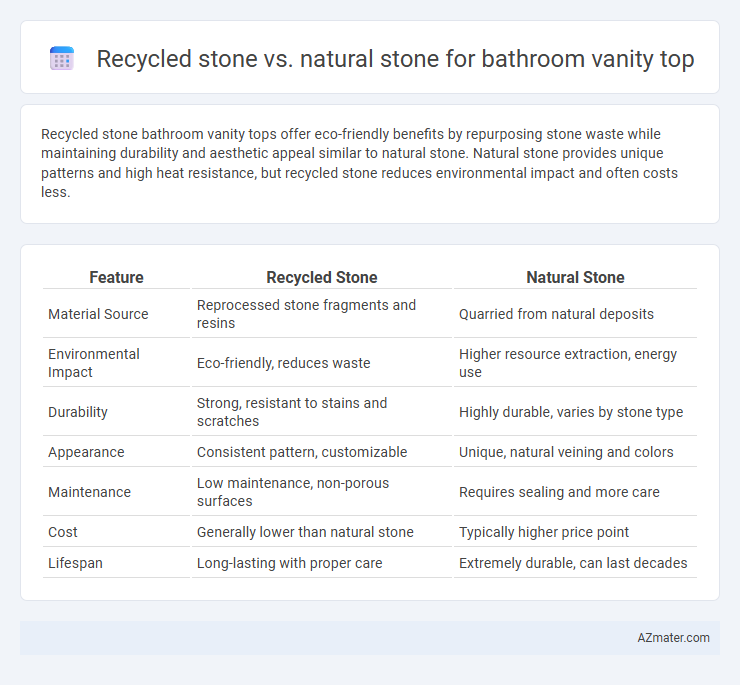Recycled stone bathroom vanity tops offer eco-friendly benefits by repurposing stone waste while maintaining durability and aesthetic appeal similar to natural stone. Natural stone provides unique patterns and high heat resistance, but recycled stone reduces environmental impact and often costs less.
Table of Comparison
| Feature | Recycled Stone | Natural Stone |
|---|---|---|
| Material Source | Reprocessed stone fragments and resins | Quarried from natural deposits |
| Environmental Impact | Eco-friendly, reduces waste | Higher resource extraction, energy use |
| Durability | Strong, resistant to stains and scratches | Highly durable, varies by stone type |
| Appearance | Consistent pattern, customizable | Unique, natural veining and colors |
| Maintenance | Low maintenance, non-porous surfaces | Requires sealing and more care |
| Cost | Generally lower than natural stone | Typically higher price point |
| Lifespan | Long-lasting with proper care | Extremely durable, can last decades |
Introduction to Bathroom Vanity Top Materials
Bathroom vanity tops made from recycled stone offer eco-friendly alternatives by incorporating reclaimed materials such as crushed glass, concrete, and natural stone fragments, reducing environmental impact. Natural stone options like granite, marble, and quartz provide timeless durability, unique veining, and heat resistance that enhance bathroom aesthetics. Selecting between recycled and natural stone depends on budget, sustainability preferences, and desired visual appeal for a customized bathroom vanity.
What is Recycled Stone?
Recycled stone is a sustainable material made from crushed natural stone, glass, and concrete remnants combined with resin binders to create durable bathroom vanity tops. This eco-friendly alternative reduces landfill waste and conserves natural resources while offering a variety of colors and textures that mimic traditional natural stone. Compared to natural stone, recycled stone is often more affordable, resistant to stains and scratches, and requires less maintenance.
What is Natural Stone?
Natural stone, such as granite, marble, and quartzite, is a durable and visually appealing material quarried directly from the earth, valued for its unique patterns and long-lasting properties in bathroom vanity tops. It offers natural variations in color and texture, enhancing the aesthetic appeal while being resistant to heat and scratches. Natural stone requires periodic sealing to maintain its moisture resistance and prevent staining in high-use bathroom environments.
Aesthetic Differences: Recycled vs Natural Stone
Recycled stone bathroom vanity tops often exhibit a unique, speckled appearance with varied hues and embedded glass or terrazzo fragments, creating an artistic and contemporary aesthetic. Natural stone, such as marble or granite, offers classic, consistent veining, depth, and rich textures that provide timeless elegance and organic beauty. The aesthetic choice between recycled and natural stone depends on desired design impact--bold and eco-friendly patterns versus traditional, refined stone characteristics.
Durability and Longevity Comparison
Recycled stone vanity tops, made from crushed natural materials bound with resin, offer impressive durability but may be more susceptible to chipping or discoloration over time compared to natural stone. Natural stone options like granite and marble provide exceptional longevity due to their dense, non-porous structure and resistance to heat and moisture, making them ideal for high-use bathroom environments. Both materials require proper sealing and maintenance to maximize lifespan, but natural stone typically outperforms in terms of enduring strength and classic aging characteristics.
Environmental Impact and Sustainability
Recycled stone countertops for bathroom vanity tops significantly reduce environmental impact by utilizing waste materials like glass, concrete, and natural stone fragments, minimizing landfill contributions and conserving natural resources. Natural stone, while durable and beautiful, involves quarrying processes that lead to habitat disruption, high energy consumption, and carbon emissions. Choosing recycled stone promotes sustainability by lowering carbon footprints and supporting circular economy principles, making it an eco-friendly alternative to conventional natural stone countertops.
Maintenance and Care Requirements
Recycled stone vanity tops offer low maintenance as they are non-porous and resistant to stains, requiring only regular wiping with mild soap and water to maintain their appearance. Natural stone surfaces like granite or marble demand more care, including periodic sealing to prevent moisture absorption and staining, along with gentle cleaning products to avoid surface damage. Homeowners seeking convenience and durability often prefer recycled stone for bathroom vanity tops due to its easy upkeep and long-lasting resistance to scratches and discoloration.
Cost and Value Considerations
Recycled stone bathroom vanity tops generally cost 20-40% less than natural stone options like granite or marble, making them a budget-friendly choice without sacrificing durability. While natural stone offers unique veining and higher resale value, recycled stone provides comparable strength and eco-friendly appeal, adding sustainable value to your bathroom. Considering installation and maintenance costs, recycled stone often presents a lower total cost of ownership with sufficient long-term appeal.
Installation: Recycled Stone vs Natural Stone
Recycled stone bathroom vanity tops typically offer easier installation due to their consistent composition and lighter weight compared to natural stone. Natural stone requires precise handling and professional expertise to prevent cracking or damage during installation because of its variable thickness and brittleness. Both materials may need proper sealing after installation, but recycled stone often allows for quicker and more straightforward fitting in standard vanity designs.
Which Stone is Best for Your Bathroom Vanity Top?
Recycled stone offers eco-friendly benefits and often incorporates a mix of crushed glass, marble, and quartz, providing durability and a unique aesthetic for bathroom vanity tops. Natural stone such as granite, marble, or quartzite delivers timeless beauty and exceptional hardness but requires more maintenance to prevent staining and etching. Choosing the best stone depends on your preference for sustainability, durability, maintenance, and budget, with recycled stone favored for environmental impact and natural stone prized for authentic appearance and longevity.

Infographic: Recycled stone vs Natural stone for Bathroom vanity top
 azmater.com
azmater.com